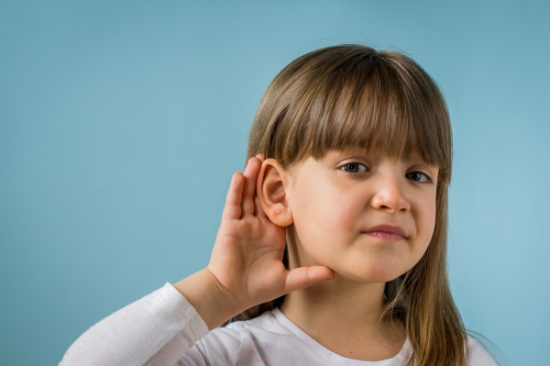Hearing is a critical sense for language development, communication, and learning. It is through hearing that children first begin to make sense of the world around them—recognizing voices, responding to sounds, and gradually acquiring the ability to speak and express themselves. From the earliest months of life, auditory input plays a central role in building cognitive and emotional connections. For children, especially in their formative years, the ability to hear sounds clearly is vital to engage with others, understand their environment, and develop essential life skills.
What is Hearing Impairment Disability?
Hearing impairment disability refers to a partial or complete inability to hear sounds, either in one or both ears. It is considered a disability when it interferes with normal development—particularly speech and language, social skills, and education.
Key facts:
- Hearing loss can be mild, moderate, severe, or profound.
- It can be temporary (due to infections) or permanent (due to genetic causes or nerve damage).
- Children with hearing impairment often require specialized teaching methods, therapy, and assistive devices such as hearing aids or cochlear implants.

Hearing Impaired Meaning: Explained Simply
The term hearing impaired means a person who experiences reduced hearing ability. It covers a wide range of conditions from slight difficulty in detecting soft sounds to complete deafness.
However, it’s essential to understand the context and preferences:
- Deaf – Someone with profound hearing loss who may use sign language as a primary form of communication.
- Hard of hearing – Someone with mild to severe hearing loss who often benefits from hearing aids or lip-reading.
While hearing impaired meaning is a useful term medically, it’s encouraged to use person-first language or respect individual preferences (e.g., “child with hearing loss”).
Classification of Hearing Impairment
Understanding the classification of hearing impairment helps determine the right therapy and communication approach.
A. Based on Degree of Hearing Loss
Degree | Hearing Loss Level | Example |
Mild | 26–40 dB | Trouble hearing whispers or soft speech |
Moderate | 41–55 dB | Difficulty following group conversations |
Moderately Severe | 56–70 dB | Cannot hear speech without amplification |
Severe | 71–90 dB | Only very loud sounds are detected |
Profound | 90+ dB | Unable to hear speech sounds |
B. Based on Cause or Origin
- Conductive hearing loss: Outer or middle ear issue (e.g., fluid, wax, infection)
- Sensorineural hearing loss: Inner ear or nerve damage (usually permanent)
- Mixed: Combination of both
C. Based on Time of Onset
- Congenital hearing loss: Present at birth
- Acquired hearing loss: Occurs after birth, due to infections, trauma, or noise exposure
D. Based on Language Development
- Pre-lingual: Before the child develops speech
- Post-lingual: After the child has developed language skills
Types of Hearing Impairment
Let’s explore the types of hearing impairment in greater detail:
1. Conductive Hearing Loss
- Caused by blockage or damage in the outer/middle ear.
- Common in young children.
- May be temporary and treatable with medical care.
- Example: A child with frequent colds may have fluid buildup affecting hearing.
2. Sensorineural Hearing Loss
- Caused by problems in the cochlea or auditory nerve.
- Often permanent.
- Hearing aids or cochlear implants may be recommended.
- Example: A child born with underdeveloped cochlear hair cells.
3. Mixed Hearing Loss
- A combination of conductive and sensorineural.
- Requires both medical and therapeutic approaches.
4. Auditory Neuropathy Spectrum Disorder (ANSD)
- Sounds enter the ear normally but are not properly processed by the brain.
- Children may hear sounds but not understand speech.
- May require assistive technology + auditory training.

Characteristics of Hearing Impairment in Children
Children with hearing impairment disability often exhibit subtle or obvious signs. These characteristics of hearing impairment can be detected early, especially when parents and caregivers are observant.
Communication & Speech
- Delayed speech or unclear pronunciation
- Difficulty forming complete sentences
- Frequent need for repetition
- Poor vocabulary growth
- Avoidance of verbal tasks
Behavioral
- Limited response to sounds or name calling
- Increased frustration or tantrums
- Inattention or appearing “daydreamy”
- Social withdrawal or limited peer interaction
Educational
- Difficulty understanding lessons in noisy environments
- Trouble following verbal instructions
- Falling behind in reading, spelling, and comprehension
- Often labeled “slow learners” in mainstream settings

Why Early Diagnosis is Crucial?
The first 5 years of a child’s life are critical for brain development, especially for speech and language. Delayed intervention can lead to:
- Academic failure
- Social isolation
- Lower self-esteem
- Emotional distress
- By age 6 months, every child with hearing loss should be:
- Diagnosed
- Fitted with hearing aids or assistive technology (if needed)
- Enrolled in therapy
How Nurturers Helps Children with Hearing Impairment Disability?
At Nurturers, we provide personalized care and support for children with hearing disabilities. Our goal is not just to improve hearing, but to help children communicate, socialize, and thrive confidently.
Our Services Include:
- Developmental Assessments
- Audiological Evaluations
- Speech & Language Therapy
- Parent Coaching & Counseling
- Special Education Support
- Use of Visual Tools, PECS & Sign Language Training
- Individualized Education Plans (IEPs)
We work hand-in-hand with parents to build a future full of possibility, inclusion, and dignity for every child.
Conclusion: Every Child Deserves to Be Heard
Understanding what is hearing impairment disability, its types, classification, and characteristics, empowers us to take early action.
If your child is showing signs of delayed speech, inattention, or difficulty responding to sound—don’t wait. Every day counts.

